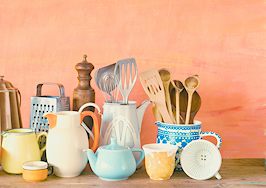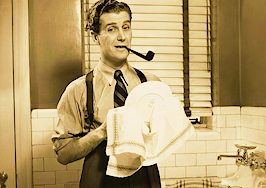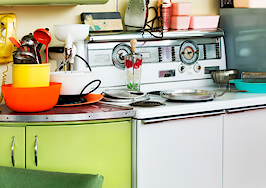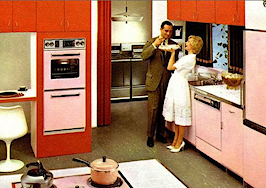Whether listing, selling or helping buyers find a new home, any real estate agent who has a basic understanding of housing styles and trends over the years, has an advantage. In real estate, knowledge, like comparables, is power.
In contrast to the “swinging 60s” characterized by “free love” brought on by birth control, drug usage and pop art, the 1970s were characterized by a recession, political corruption, high unemployment, a renewed interest in environmentalism and the beginning of widespread disenchantment with materialism.
Characteristics of 1970s home design
1970s design is defined by sleek, modern minimalism, in contrast to the playfulness and color of mid-century modernism. The first Earth Day, the modern environmental movement, took place on April 22nd, 1970. While Earth Day brought about terms like “tree hugger” and “earth shoe-wearing hippies” it clearly affected housing and lifestyles during this decade.
Sixty percent of 1970s new construction was made up of ranch houses with garages. Wood paneling, massive stone fireplaces. beams and brilliantly colored shag carpeting were apparent in every home. Floating staircases, second-floor balconies, sunken living rooms and fiber optic lighting began to appear in new houses.
Called “the decade that taste forgot” by some critics of the period, brightly colored geometric wallpaper and large-scale florals, including flocked wallpapers and mylars or foils, were popular. Houses had skylights and larger windows, while better insulation and improved heating systems were explored. Wood stoves, with the requisite water kettle on top to provide moisture, were one answer to the energy crisis.
Color and lots of it, particularly intense earth tones, was the antidote to all the wood, stone, granite, and ceramic tile found in 1970s kitchens and bathrooms. As more and more women entered the workforce outside the home, the kitchen became the gathering spot after work where dinner was prepared, homework was monitored, laundry was within close range, and family members convened to discuss their day.
Kitchens in the 1970s
The kitchen with a dining area was the standard in the 1970s. Wood beams, terracotta floors, and architectural elements such as arches, large expanses of glass, including sliders to outdoor spaces, fireplaces, and cathedral ceilings were often found in combination kitchen/family rooms.
Avocado green and harvest gold were the most widely used colors for stoves, refrigerators, dishwashers, and even sinks during this period. Almond and coppertone (brown) appliances were also commonly used, further evidence of the natural back-to-nature movement.
White and stainless steel appliances were almost unknown during this time. Patterned tiles began to appear on kitchen backsplashes as individuality and nonconformity came into vogue.
Kitchens grew in size to accommodate more than one cook, and electric appliances proliferated, despite the movement to conserve energy. In-store demonstrations of food processors, as well as cooking classes, became popular, spawning new ways of cooking and entertaining. A whole new category of cookbooks was born, geared to these new appliances.
Crockpots, microwaves, electric fondue pots, and electric knives were not just status symbols but tools to facilitate homemakers to better serve their families. These small electrics required more counter space, more sources of electricity in the kitchen, and specialized storage.
The “appliance garage” was born, a countertop area with a pull-down tambour door similar to a roll-top desk, which was often found under corner cabinets in larger cabinets. Here the mixer or food processor found a home, often connected to a dedicated power source, ready to be used without much forethought or preparation.
Bathrooms in the 1970s
Bathrooms of this decade also included the colorful tile and wallpaper found in other areas of the home, and wood vanities and paneling were popular. Larger baths dedicated to bathing and self-care had elements of sensual decadence and were known as temples of leisure.
Home gyms and home entertainment centers had yet to become popular, so the 1970s bath was the prelibation of this trend. Shag carpeting, wood paneling, and extensive walls of mirrors were everywhere in 1970s bathrooms. It is significant that the “Honeymoon Hotels” in the Poconos with red heart-shaped bathtubs were built in 1970 and viewed as the height of sensuality.
Manufacturing of colorful ceramic tile, as well as importing European tiles of varying sizes and patterns, was becoming more commonplace, providing almost endless design options for 1970s bathrooms.
Oval, octagonal, circular and oddly shaped bathroom sinks in pastel colors or even more intense hues made their appearance during the 70s. Both showers and bathtubs, often sunken tubs or raised tubs with custom surrounds were features, and individuality was prized.
After the exuberance, freedom and color explosion of 1960s design and architectural styles, the 1970s were more subdued and reflected the political, economic and financial concerns of this decade.
Real estate agents with a trained eye and understanding of design history will have an advantage with their buyers and sellers over agents that lack this awareness. A trained eye and a sensitivity to aesthetics are vastly helpful in matching properties with buyers.
Gerard Splendore is a licensed associate real estate broker with Warburg Realty in New York. Connect with him on LinkedIn.













